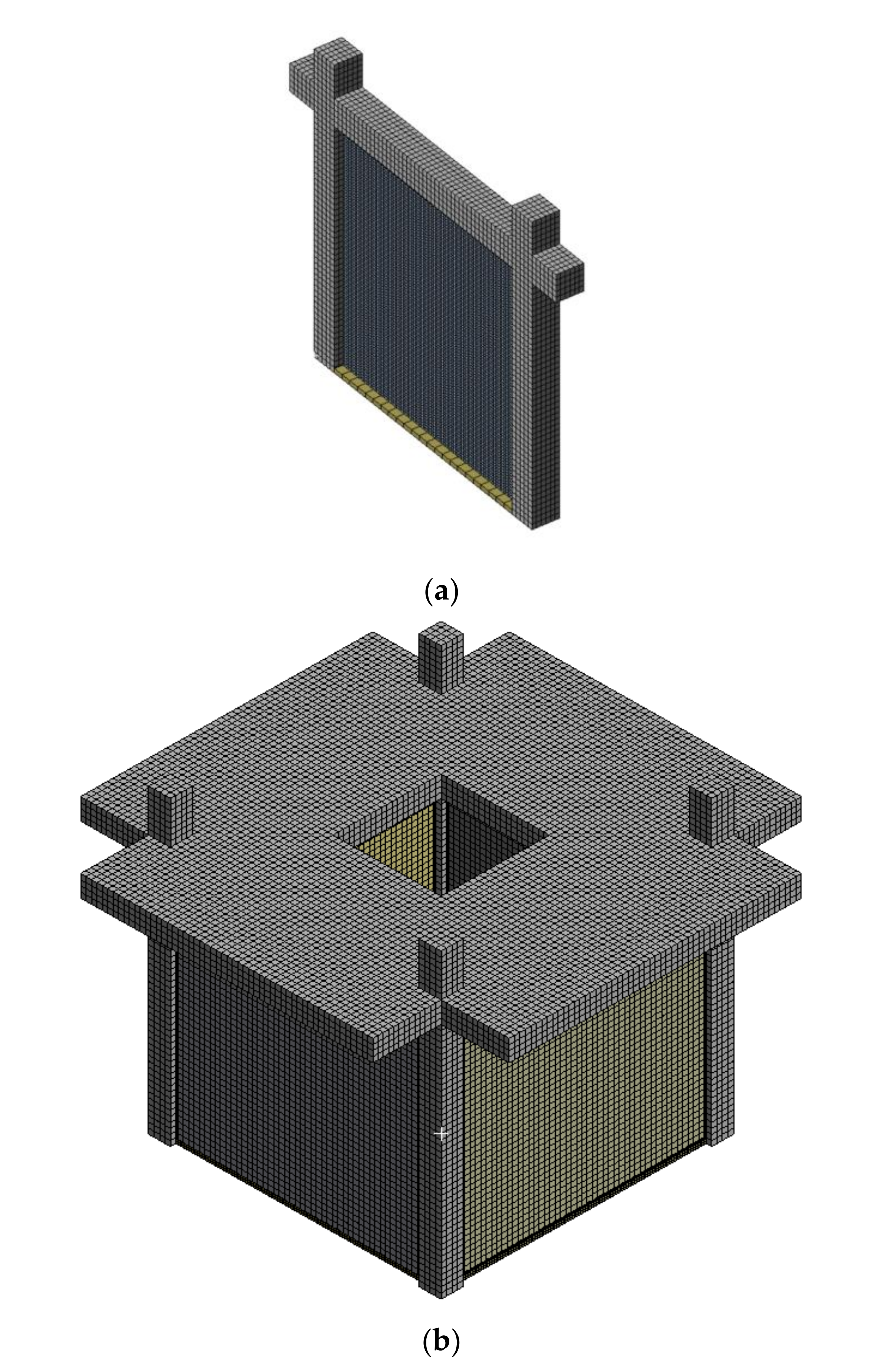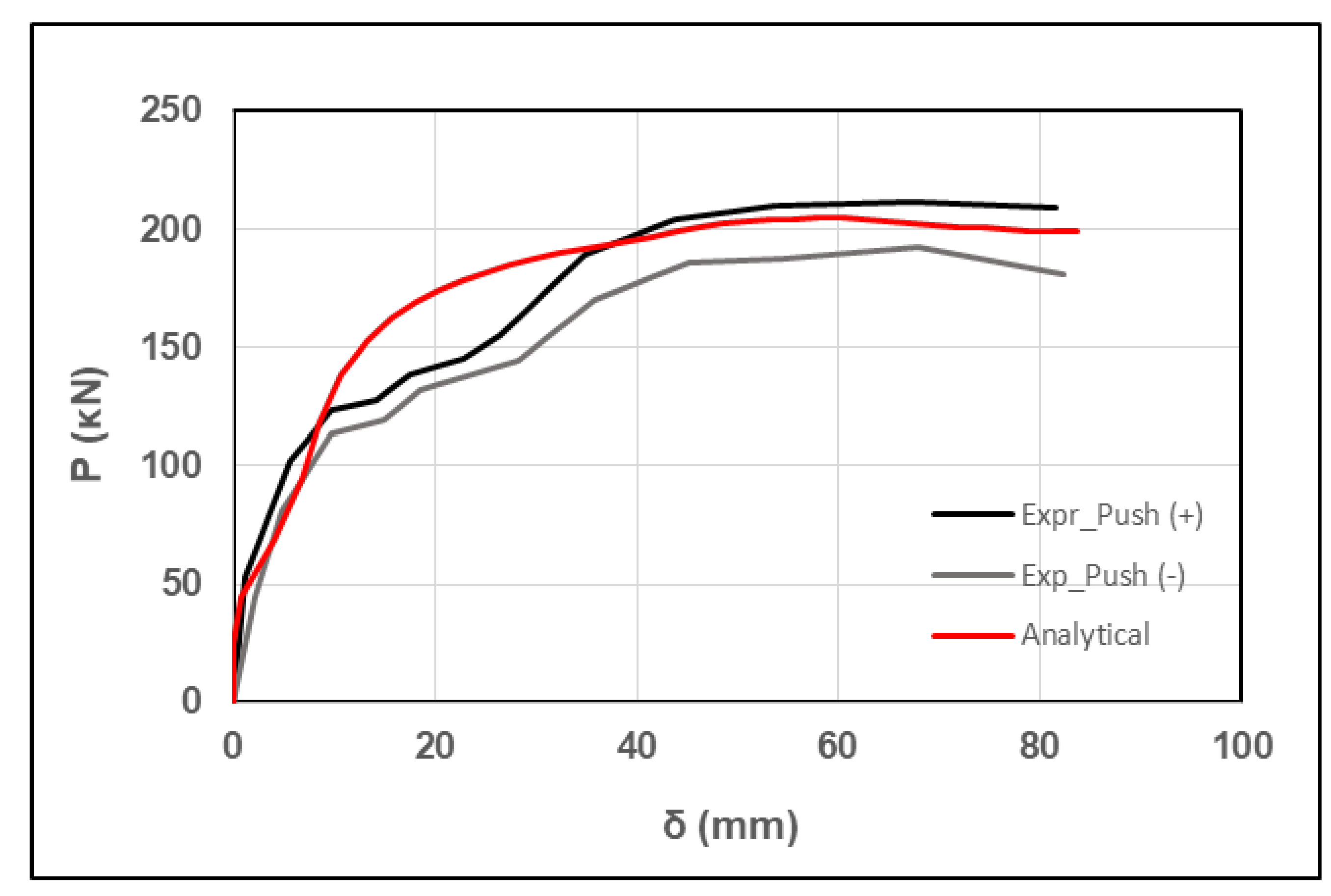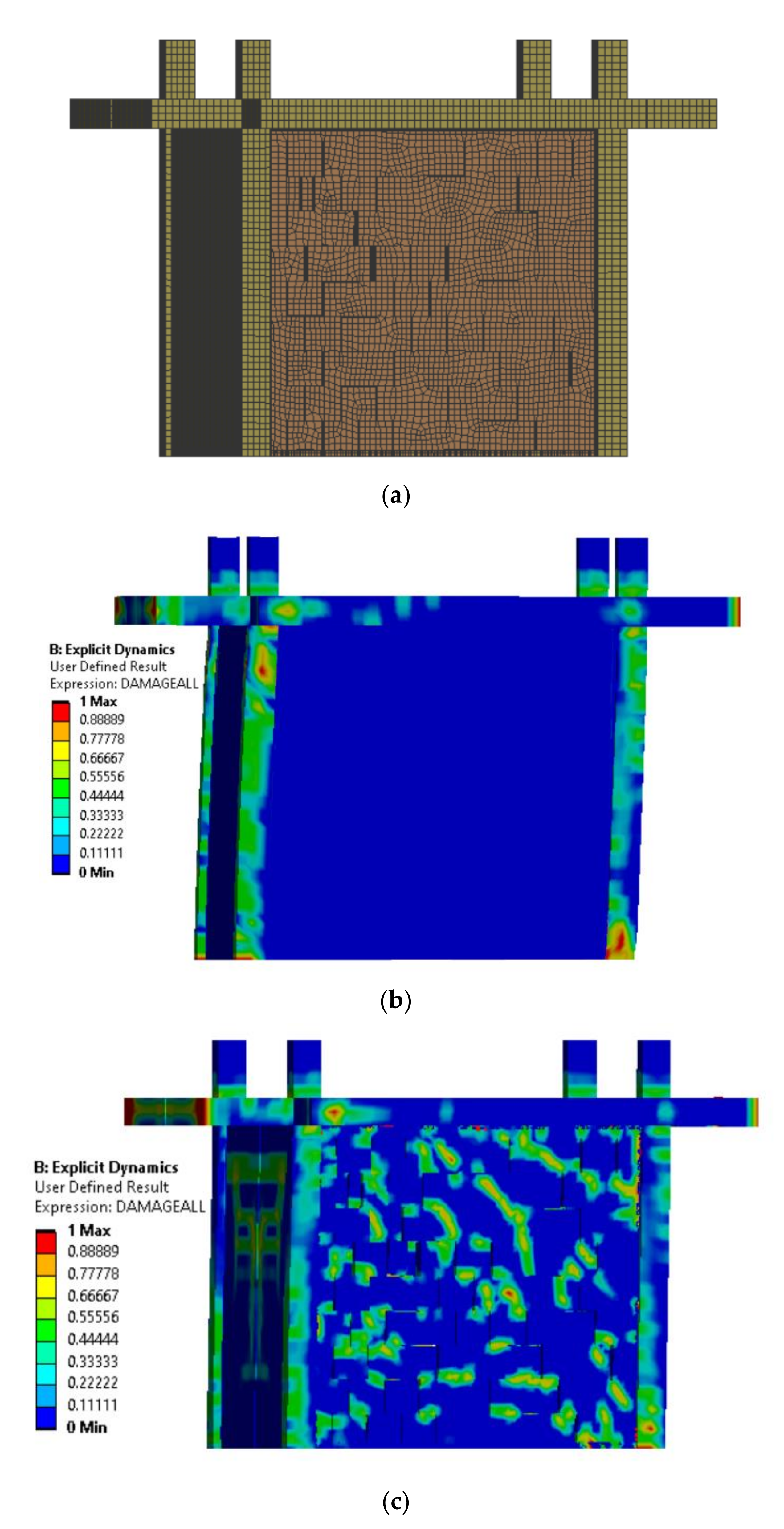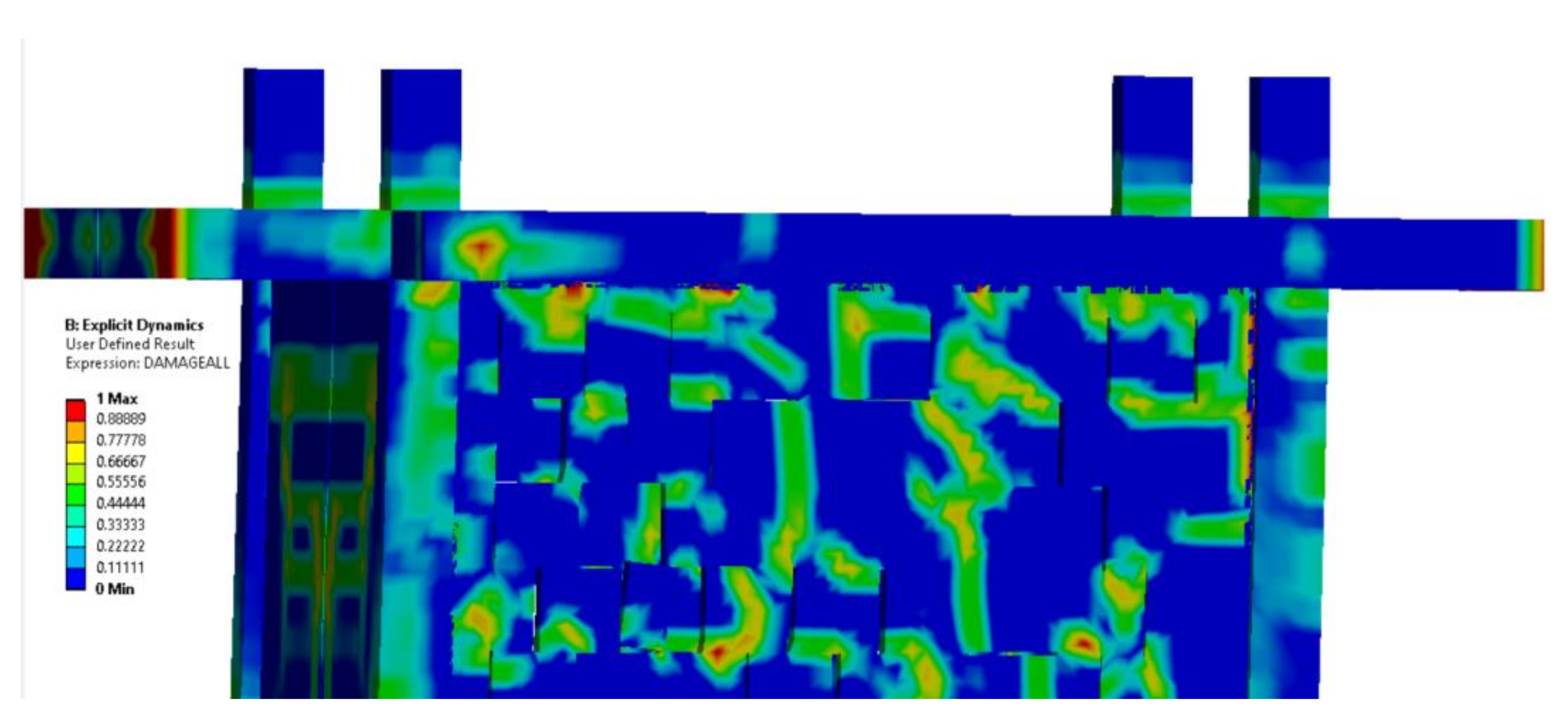3D FEA of Infilled RC Framed Structures Protected by Seismic Joints and FRP Jackets
Abstract
:1. Introduction
2. Brief Presentation of Existing Experimental Results
2.1. Seismic Protection of Infilled RC Frames with FRP Jackets
2.2. Seismic Protection of Infilled RC Structure with Highly Deformable Joints
2.2.1. Material Properties
2.2.2. Structure Detailing
2.2.3. Loading Phases
3. 3D FE Models
3.1. Geometry and Elements
3.2. Material Models
3.3. Boundary Conditions and Loads
4. 3D FE Analyses Results
4.1. A2R Frame
4.2. INMASPOL Structure
4.3. FRPU Retrofitted INMASPOL Structure with the Addition of Steel Dowels
5. Conclusions
Author Contributions
Funding
Institutional Review Board Statement
Informed Consent Statement
Data Availability Statement
Conflicts of Interest
References
- Mehrabi, A.B.; Benson-Shing, P.; Schuller, M.P.; Noland, J.L. Experimental evaluation of masonry-infilled RC frames. J. Struct. Eng. 1996, 122, 228–237. [Google Scholar] [CrossRef]
- Al-Chaar, G.; Issa, M.; Sweeney, S. Behavior of masonry-infilled nonductile reinforced concrete frames. J. Struct. Eng. 2002, 128, 1055–1063. [Google Scholar] [CrossRef]
- Almusallam, T.H.; Al-Salloum, Y.A. Behavior of FRP Strengthened Infill Walls under In-Plane Seismic Loading. J. Compos. Constr. 2007, 11, 308–318. [Google Scholar] [CrossRef]
- Akhoundi, F.; Lourenço, P.B.; Vasconcelos, G. Numerically based proposals for the stiffness and strength of masonry infills with openings in reinforced concrete frames. Earthq. Eng. Struct. Dyn. 2016, 45, 869–891. [Google Scholar] [CrossRef] [Green Version]
- Hak, S.; Morandi, P.; Magenes, G. Prediction of inter-storey drifts for regular RC structures with masonry infills based on bare frame modelling. Bull. Earthq. Eng. 2017, 16, 397–425. [Google Scholar] [CrossRef]
- Morandi, P.; Hak, S.; Magenes, G. Performance-based interpretation of in-plane cyclic tests on RC frames with strong masonry infills. Eng. Struct. 2018, 156, 503–521. [Google Scholar] [CrossRef]
- Huang, H.; Burton, H.V.; Sattar, S. Development and Utilization of a Database of Infilled Frame Experiments for Numerical Modeling. J. Struct. Eng. 2020, 146, 04020079. [Google Scholar] [CrossRef]
- Dawe, J.L.; Seah, C.K. Out-of-plane resistance of concrete masonry infilled panels. Can. J. Civ. Eng. 1989, 16, 854–864. [Google Scholar] [CrossRef]
- Angel, R.; Abrams, D.; Shapiro, D.; Uzarski, J.; Webster, M. Behavior of Reinforced Concrete Frames with Masonry Infills. Civil Engineering Studies: Structural Research Series. 1994. Available online: http://hdl.handle.net/2142/14210 (accessed on 15 May 2021).
- Walsh, K.Q.; Dizhur, D.Y.; Giongo, I.; Derakhshan, H.; Ingham, J.M. Effect of boundary conditions and other factors on URM wall out-of-plane behaviour: Design demands, predicted capacity, and in situ proof test results. SESOC J. 2017, 30, 57. [Google Scholar]
- Stavridis, A.; Koutromanos, I.; Shing, P.G. Shake-table tests of a three-story reinforced concrete frame with masonry infll walls. Earthq. Eng. Struct. Dyn. 2011, 41, 1089–1108. [Google Scholar] [CrossRef]
- Uva, G.; Porco, F.; Fiore, A. Appraisal of masonry infll walls efect in the seismic response of RC framed buildings: A case study. Eng. Struct. 2012, 34, 514–526. [Google Scholar] [CrossRef]
- Celarec, D.; Dolsek, M. Practice-oriented probabilistic seismic performance assessment of inflled frames with consideration of shear failure of columns. Earthq. Eng. Struct. Dyn. 2012, 42, 1339–1360. [Google Scholar] [CrossRef]
- Ruggieri, S.; Porco, F.; Uva, G.; Vamvatsikos, D. Two frugal options to assess class fragility and seismic safety for low-rise reinforced concrete school buildings in Southern Italy. Bull. Earthq. Eng. 2021, 19, 1415–1439. [Google Scholar] [CrossRef]
- Yuksel, E.; Ilki, A.; Erol, G.; Demir, C.; Karadogan, H.F. Seismic retrofitting of infilled reinforced concrete frames with CFRP composites. In Advances in Earthquake Engineering for Urban Risk Reduction; Wasti, S.T., Ozcebe, G., Eds.; Springer: Dordrecht, The Netherlands, 2006; pp. 285–300. [Google Scholar] [CrossRef]
- Altin, S.; Anil, Ö.; Kara, E.M.; Kaya, M. An experimental study on strengthening of masonry infilled RC frames using diagonal CFRP strips. Compos. Part B Eng. 2008, 39, 680–693. [Google Scholar] [CrossRef]
- Ozden, S.; Akguzel, U.; Ozturan, T. Seismic strengthening of infilled reinforced concrete frames with composite materials. ACI Struct. J. 2011, 108, 414–422. [Google Scholar] [CrossRef]
- Koutas, L.; Bousias, S.N.; Triantafillou, T.C. Seismic strengthening of masonry-infilled RC frames with TRM: Experimental study. J. Compos. Constr. 2014, 19. [Google Scholar] [CrossRef]
- Gams, M.; Tomaževič, M.; Berset, T. Seismic strengthening of brick masonry by composite coatings: An experimental study. Bull. Earthq. Eng. 2017, 15, 4269–4298. [Google Scholar] [CrossRef]
- Rousakis, T.; Ilki, A.; Kwiecień, A.; Viskovic, A.; Gams, M.; Triller, P.; Ghiassi, B.; Benedetti, A.; Rakicevic, Z.; Colla, C.; et al. Deformable Pol-yurethane Joints and Fibre Grids for Resilient Seismic Performance of Reinforced Concrete Frames with Orthoblock Brick Infills. Polymers 2020, 12, 2869. [Google Scholar] [CrossRef]
- Fardis, M.N. Design provisions for masonry-infilled RC frames. In Proceedings of the 12th World Conference on Earthquake Engineering, Auckland, New Zealand, 30 January–4 February 2000. [Google Scholar]
- Marinkovic, M.; Butenweg, C. Innovative decoupling system for the seismic protection of masonry infill walls in reinforced concrete frames. Eng. Struct. 2019, 197, 109435. [Google Scholar] [CrossRef]
- Butenweg, C.; Marinković, M. Damage reduction system for masonry infill walls under seismic loading. Bull. Earthq. Eng. 2018, 2, 267–273. [Google Scholar] [CrossRef]
- Rousakis, T. Brick walls Interventions with FRPU or PUFJ and of RC columns with FR in Brick-Infilled RC Structures with the use of Pushover Beam-Column Element Analysis and Pseudo-Dynamic 3D Finite Element Analysis. In Proceedings of the 17th International Brick and Block Masonry Conference from Historical to Sustainable Masonry (IB2MaC 2020), Krakow, Poland, 5–7 July 2020. [Google Scholar]
- Akyildiz, A.; Kwiecień, A.; Zając, B.; Triller, P.; Bohinc, U.; Rousakis, T.; Viskovic, A. Preliminary in-plane shear test of infills protected by PUFJ interfaces. In Proceedings of the 17th International Brick and Block Masonry Conference from Historical to Sustainable Masonry (IB2MaC 2020), Krakow, Poland, 5–7 July 2020. [Google Scholar]
- Karabinis, A.I.; Rousakis, T.C.; Manolitsi, G.E. 3D Finite-Element Analysis of Substandard RC Columns Strengthened by Fiber-Reinforced Polymer Sheets. J. Compos. Constr. 2008, 12, 531–540. [Google Scholar] [CrossRef]
- Rousakis, T.; Karabinis, A. Fiber Reinforced Polymer Confinement of Bridge Columns Suffering from Premature Bars’ Buckling–Strength empirical model. In Proceedings of the 34th International Symposium on Bridge and Structural Engineering, Venice, Italy, 22–24 September 2010. [Google Scholar]
- Yu, T.T.; Teng, J.G.; Wong, Y.L.; Dong, S.L. Finite element modeling of confined concrete-I: Drucker–Prager type plasticity model. Eng. Struct. 2010, 32, 665–679. [Google Scholar] [CrossRef]
- Hany, N.F.; Hantouche, E.G.; Harajli, M.H. Finite element modeling of FRP-confined concrete using modified concrete damaged plasticity. Eng. Struct. 2016, 125, 1–14. [Google Scholar] [CrossRef]
- Youssef, O.; El Gawady, M.A.; Mills, J.E. Displacement and plastic hinge length of FRP confined circular reinforced concrete columns. Eng. Struct. 2015, 101, 465–476. [Google Scholar] [CrossRef]
- Yuan, F.; Wu, Y.F.; Li, C.Q. Modelling plastic hinge of FRP-confined RC columns. Eng. Struct. 2017, 131, 651–668. [Google Scholar] [CrossRef]
- Triantafyllou, G.G.; Rousakis, T.C.; Karabinis, A.I. Effect of patch repair and strengthening with EBR and NSM CFRP laminates for RC beams with low, medium and heavy corrosion. Compos. Part B Eng. 2018, 133, 101–111. [Google Scholar] [CrossRef]
- Anagnostou, E.; Rousakis, T.; Georgiadis, N. Finite element analysis of deficient RC columns with square and rectangular section under pseudoseismic load and comparison with retrofit code predictions. In Proceedings of the ICCE-26 Conference, Paris, France, 15–21 July 2018. [Google Scholar]
- Fanaradelli, T.D.; Rousakis, T.C. 3D Finite Element Pseudodynamic Analysis of Deficient RC Rectangular Columns Confined with Fiber Reinforced Polymers under Axial Compression. Polymers 2020, 12, 2546. [Google Scholar] [CrossRef] [PubMed]
- Triller, P.; Kwiecien, A.; Bohinc, U.; Zajac, B.; Rousakis, T.; Viskovic, A. Preliminary in-plane shear test of damaged infill strengthened by FRPU. In Proceedings of the 10th International Conference on FRP Composites in Civil Engineering (CICE 2020/2021), Istanbul, Turkey, 8–10 December 2021. [Google Scholar]
- Eurocode 2: Design of Concrete Structures—Part 1-1: General Rules and Rules for Buildings; British Standard: London, UK, 2008.
- Eurocode 8. Design of Structures for Earthquake Resistance—Part 1: General Rules, Seismic Actions and Rules for Buildings; British Standard: London, UK, 2004.
- Kwiecień, A. Stiff and flexible adhesives bonding CFRP to masonry substrates—Investigated in pull-off test and Single-Lap test. Arch. Civ. Mech. Eng. 2012, 12, 228–239. [Google Scholar] [CrossRef]
- ANSYS® Academic Research, Release v 2021 R1. Available online: https://www.ansys.com/products/release-highlights (accessed on 15 May 2021).
- Riedel, W. Beton Unter Dynamischen Lasten: Meso- und Makromechanische Modelle und ihre Parameter; Fraunhofer-Institut für Kurzzeitdynamik, Ernst-Mach-Institut EMI, Freiburg/Brsg, Eds.; Fraunhofer IRB Verlag: Stuttgart, Germany, 2004; ISBN 3-8167-6340-5. [Google Scholar]
- Riedel, W.; Thoma, K.; Hiermaier, S.; Schmolinske, E. Penetration of Reinforced Concrete by BETA-B-500, Numerical Analysis using a New Macroscopic Concrete Model for Hydrocodes. In Proceedings of the 9th International Symposium, Interaction of the Effects of Munitions with Structures, Berlin, Germany, 3–7 May 1999; pp. 315–322. [Google Scholar]
- Riedel, W.; Kawai, N.; Kondo, K. Numerical Assessment for Impact Strength Measurements in Concrete Materials. Int. J. Impact Eng. 2009, 36, 283–293. [Google Scholar] [CrossRef] [Green Version]
- El Mezaini, N.S. Reserved Strength of Reinforced Concrete Buildings with Masonry Walls. Comput. Civ. Infrastruct. Eng. 2005, 20, 172–183. [Google Scholar] [CrossRef]
- Facconi, L.; Minelli, F. Retrofitting RC infills by a glass fiber mesh reinforced overlay and steel dowels: Experimental and numerical study. Constr. Build. Mater. 2020, 231, 117133. [Google Scholar] [CrossRef]








| b (mm) | h (mm) | H (mm) | Longitudinal Steel Bars | Stirrups | |
|---|---|---|---|---|---|
| Columns | 250 | 250 | 2450 1 | 8Φ16 | Φ10/100 |
| Foundation beam | 300 | 400 | 3550 | 4Φ25 + 4Φ20 + 2Φ16 | Φ10/100 |
| Top beam | 250 | 250 | 3550 | 8Φ14 | Φ10/100 |
| Material | Density (kg/m3) | Structural Element | Property | Value |
|---|---|---|---|---|
| Concrete | 2380 | Foundation | Compressive strength 1 | 34.1 MPa |
| Columns | 27.1 MPa | |||
| Slab | 34.2 MPa | |||
| Steel | 7850 | Reinforcement | Characteristic yield strength | 500 MPa |
| Clay | 1800 | OrthoBlock | Weight | 100 kg/m2 |
| Glass Fiber | 2600 | In FRPU jacket | Elastic modulus | 80 GPa |
| Strength | 2600 MPa | |||
| Ultimate elongation | 4% | |||
| Polyurethane | 910 | PUFJ | Elastic modulus | 4 MPa |
| Strength | 1.4 MPa | |||
| Ultimate elongation | 110% | |||
| In FRPU jacket | Elastic modulus | 16 MPa | ||
| Strength | 2.5 MPa | |||
| Ultimate elongation | 40% |
| Height (mm) | Length (mm) | Width (mm) | |
|---|---|---|---|
| Infill | 2300 | 2300 | 100 |
| Brick Unit | 240 | 250 | 100 |
| Bed Joint | - | - | 3 (thickness) |
| Head Joint | - | - | 3 (thickness) |
| Wall B FRPU | - | - | 20 (thickness) 3 sides |
| Wall C FRPU | - | - | 20 (thickness) 4 sides |
| Beam | 200 | 2300 | 200 |
| Columns | 2500 | 200 | 200 |
| Beam–Column Joint | 200 | 200 | 200 |
| Columns | Beam | |
|---|---|---|
| Longitudinal | 8Φ10 | 8Φ10 |
| Transverse peripheral | Φ8/50 | Φ8/50 |
| Transverse rhombic | Φ8/50 | - |
| Additional Information | ||
| Clear concrete cover | 42 mm | |
| Slab thickness/Reinforcement | 200 mm/Q503 | |
| Total 7200 kg mass anchored on the top of the slab | ||
| RHT Concrete Model Brief Presentation | ||
|---|---|---|
| Equation | No | Definition |
| (1) | Generalized failure surface | |
| (2) | Fracture surface | |
| (3) | Rate-dependent enhancement factor | |
| (4) | Third invariant dependence term | |
| (5) | Bilinear strain hardening function for the case of uniaxial compression | |
| (6) | Damage is assumed to accumulate due to inelastic deviatoric straining (shear-induced cracking) | |
| (7) | Strain softening | |
| (8) | The shear modulus reduction | |
| (9) | Maximum tensile pressure in the material is limited | |
| A2R | |||
|---|---|---|---|
| Exp. | Anal. | AD (%) | |
| Pmax (+) (kN) | 214.1 | 204.7 | 4.4 |
| δPmax (+) (mm) | 65.0 | 59.1 | 9.1 |
| Pmax (−) (kN) | 190.6 | 204.7 | 7.4 |
| δPmax (−) (mm) | 65.0 | 59.1 | 9.1 |
| Pu (+) (kN) | 210.4 | 199.1 | 5.4 |
| δPu (+) (mm) | 81.4 | 81.4 | - |
| Pu (−) (kN) | 178.7 | 199.1 | 11.4 |
| δPu (−) (mm) | 81.4 | 81.4 | - |
Publisher’s Note: MDPI stays neutral with regard to jurisdictional claims in published maps and institutional affiliations. |
© 2021 by the authors. Licensee MDPI, Basel, Switzerland. This article is an open access article distributed under the terms and conditions of the Creative Commons Attribution (CC BY) license (https://creativecommons.org/licenses/by/4.0/).
Share and Cite
Rousakis, T.; Vanian, V.; Fanaradelli, T.; Anagnostou, E. 3D FEA of Infilled RC Framed Structures Protected by Seismic Joints and FRP Jackets. Appl. Sci. 2021, 11, 6403. https://doi.org/10.3390/app11146403
Rousakis T, Vanian V, Fanaradelli T, Anagnostou E. 3D FEA of Infilled RC Framed Structures Protected by Seismic Joints and FRP Jackets. Applied Sciences. 2021; 11(14):6403. https://doi.org/10.3390/app11146403
Chicago/Turabian StyleRousakis, Theodoros, Vachan Vanian, Theodora Fanaradelli, and Evgenia Anagnostou. 2021. "3D FEA of Infilled RC Framed Structures Protected by Seismic Joints and FRP Jackets" Applied Sciences 11, no. 14: 6403. https://doi.org/10.3390/app11146403
APA StyleRousakis, T., Vanian, V., Fanaradelli, T., & Anagnostou, E. (2021). 3D FEA of Infilled RC Framed Structures Protected by Seismic Joints and FRP Jackets. Applied Sciences, 11(14), 6403. https://doi.org/10.3390/app11146403







